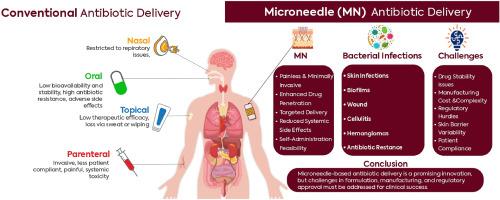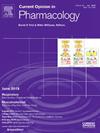Advanced microneedle arrays for transdermal antibiotic delivery
IF 4.2
3区 医学
Q1 PHARMACOLOGY & PHARMACY
引用次数: 0
Abstract
Traditional antibiotic delivery methods face limitations including, systemic toxicity and poor bioavailability. Transdermal microneedle (MN) arrays bypass skin barriers, enhancing antibiotic penetration while minimizing resistance risks. This review examines advanced MN systems such as solid, coated, hollow, dissolvable, and smart stimuli-responsive, highlighting design innovations, nanomaterial integration, and preclinical efficacy against infections like methicillin-resistant Staphylococcus aureus (MRSA). While MN technology enables targeted, minimally invasive delivery, clinical adoption requires overcoming scalability hurdles and demonstrating real-world efficacy. Comprehensive clinical validation remains essential to translate these systems into mainstream solutions for combating antibiotic resistance and improving chronic wound management.

用于经皮给药的先进微针阵列
传统的抗生素给药方法存在局限性,包括全身毒性和生物利用度差。透皮微针(MN)阵列绕过皮肤屏障,增强抗生素渗透,同时最大限度地降低耐药风险。本文综述了先进的MN系统,如固体、涂层、空心、可溶解和智能刺激反应,强调了设计创新、纳米材料集成和抗耐甲氧西林金黄色葡萄球菌(MRSA)感染的临床前疗效。虽然MN技术可以实现有针对性的微创输送,但临床应用需要克服可扩展性障碍并证明实际疗效。全面的临床验证对于将这些系统转化为对抗抗生素耐药性和改善慢性伤口管理的主流解决方案仍然至关重要。
本文章由计算机程序翻译,如有差异,请以英文原文为准。
求助全文
约1分钟内获得全文
求助全文
来源期刊
CiteScore
8.80
自引率
2.50%
发文量
131
审稿时长
4-8 weeks
期刊介绍:
Current Opinion in Pharmacology (COPHAR) publishes authoritative, comprehensive, and systematic reviews. COPHAR helps specialists keep up to date with a clear and readable synthesis on current advances in pharmacology and drug discovery. Expert authors annotate the most interesting papers from the expanding volume of information published today, saving valuable time and giving the reader insight on areas of importance.

 求助内容:
求助内容: 应助结果提醒方式:
应助结果提醒方式:


